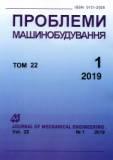Experimental Strength Analysis of Variable Stiffness Waffel-Grid Cylindrical Compartments. Part 1. Experimental Procedure
Keywords:
tail section, waffle-grid cylindrical shell, strain gauges, loadAbstract
This paper proposes a method of the experimental study of the static stress-strain state (SSS) of the variable stiffness tail section of a launch vehicle (LV). The tail section consists of a body and a support ring. The body is a welded structure made up of two waffel-grid shells and two end frames. On the upper and lower end frames, there are bolt holes and guide pins for mating the frames to the fuel tank and support ring, respectively. The shells are made of AMg6NPP, and the frames, of AMg6M aluminum alloys, respectively. The tail section body is loaded through the four support brackets of the power ring, which is part of the test assembly. The article summarizes the results of the experimental analysis of the static SSS of an optimized tail section body under the conditions of loading close to realistic ones. As a result of the experimental research, we achieved the following goals: obtained data on the tail section body strength taking into account the design features, manufacturing technology, and mechanical characteristics of the material; tested theoretical methods for calculating structural strength; determined stresses in the places where they can most reliably be found only experimentally; identified structural sections that have enough strength to be subsequently decreased. Different-size static force factors were applied to the tail section. The static loading of the structure was performed in stages without dynamic components. When the tail section body was tested, measurements of the displacements and deformations were made. The deformations were measured for three different values of the shell longitudinal coordinate and at various points along the circumferential coordinate of the structure. At each point, two rosette strain gauges were glued. One strain gauge was glued in the longitudinal, and the other, in the circumferential direction. With the help of the proposed method, we investigated SSS of the tail section that was designed by the Yuzhnoye Design Bureau.
References
Mossakovskiy, V. I., Makarenkov, A. G., Nikitin, P. I., Savin, Yu. I., & Spiridonov, I.N. (1990). Prochnost raketnykh konstruktsiy [Strength of rocket constructions].Moscow: Vyshcha shkola, 358 p. (in Russian).
Amiro, I.Ya., & Zarutskiy, V. A. (1980). Teoriya rebristykh obolochek [Theory of ribbed shells]. Kiyev: Naukova dumka, 367 p. (in Russian).
Amiro, I. Ya., Grachev, O. A., Zarutskiy, V. A., Palchevskiy, A. S., & Sannikov, Yu. A. (1987). Ustoychivost rebristykh obolochek vrashcheniya [Stability of ribbed shells of revolution]. Kiyev: Naukova dumka, 180 p. (in Russian).
Andrianov, I.V., Lesnichaya, V. A., Loboda, V. V., & Manevich, L. I. (1986). Raschet prochnosti rebristykh obolochek inzhenernykh konstruktsiy [Calculation of strength of ribbed shells of engineering structures]. Kiyev;Donetsk: Vyshcha shkola, 167 p. (in Russian).
Lizin, V. T. & Pyatkin, V. A. (1994). Proyektirovaniye tonkostennykh konstruktsiy [Design of thin-walled structures].Moscow: Mashinostroyeniye, 247 p. (in Russian).
(1989). Raschety mashinostroitelnykh konstruktsiy metodom konechnykh elementov: spravochnik (pod obshchey red. V. I. Myachenkova) [Myachenkov, V.I. (Ed.). Calculations of engineering constructions by the finite element method: A handbook].Moscow: Mashinostroyeniye, 456 p. (in Russian).
Karmishin, A. V., Lyaskovets, V. A., Myachenkov, V. I., & Frolov, A. N. (1975). Statika i dinamika tonkostennykh obolochechnykh konstruktsiy [Statics and dynamics of thin-walled shell structures].Moscow: Mashinostroyeniye, 280 p. (in Russian).
Pechnikov, V. P., Zakharov, R. V., & Tarasova, A. V. (2007). Proyektirovaniye vafelnykh obolochek toplivnykh bakov rakety s uchetom plasticheskikh deformatsiy [Designing waffle-grid shells for rocket fuel tanks with regard to plastic deformations]. Inzh. zhurn.: nauka i innovatsii – Engineering Journal: Science and Innovations, vol. 11, pp. 1–14 (in Russian).
Kondratyev, A. V. (2010). Proyektirovaniye golovnykh obtekateley raket-nositeley iz polimernykh kompozitnykh materialov pri odnovremennom teplovom i silovom vozdeystvii [Designing head fairings of launch vehicles from polymer composite materials with simultaneous thermal and force impact]. Vopr. proyektirovaniya i pro-va konstruktsiy letat. apparatov – Issues of Design and Manufacture of Flying Vehicles, vol. 4, pp. 11–22 (in Russian).
Gudramovich, V. S., Gart, E. L., Klimenko, D. V., Tonkonozhenko, A. M., & Ryabokon, S. A. (2011). Konechno- elementnyy analiz uprugo-plasticheskogo napryazhenno-deformirovannogo sostoyaniya otsekov raketnykh konstruktsiy s vyrezami [Finite-element analysis of the elastic-plastic stress-deformed state of the cut-out sections of rocket structures]. Tekhn. mekhanika – Technical Mechanics, vol. 4, pp. 52–61 (in Russian).
Downloads
Published
Issue
Section
License
Copyright (c) 2019 M. A. Degtyarev, V. G. Danchenko, A. V. Shapoval, K. V. Avramov

This work is licensed under a Creative Commons Attribution-NoDerivatives 4.0 International License.
All authors agree with the following conditions:
- The authors reserve the right to claim authorship of their work and transfer to the journal the right of first publication of the work under the license agreement (the agreement).
- Authors have a right to conclude independently additional agreement on non-exclusive spreading the work in the form in which it was published by the jpurnal (for example, to place the work in institution repository or to publish as a part of a monograph), providing a link to the first publication of the work in this journal.
- Journal policy allows authors to place the manuscript in the Internet (for example, in the institution repository or on a personal web sites) both before its submission to the editorial board and during its editorial processing, as this ensures the productive scientific discussion and impact positively on the efficiency and dynamics of citation of published work (see The Effect of Open Access).

